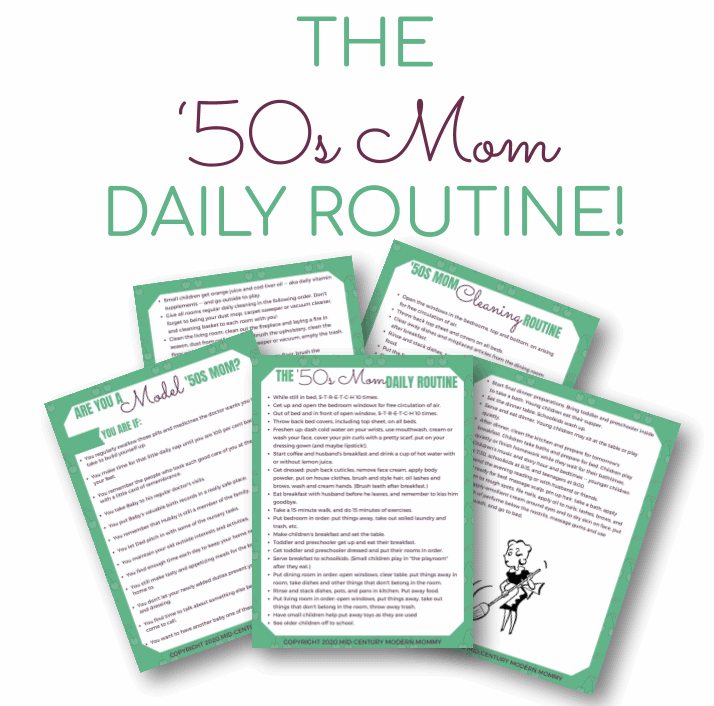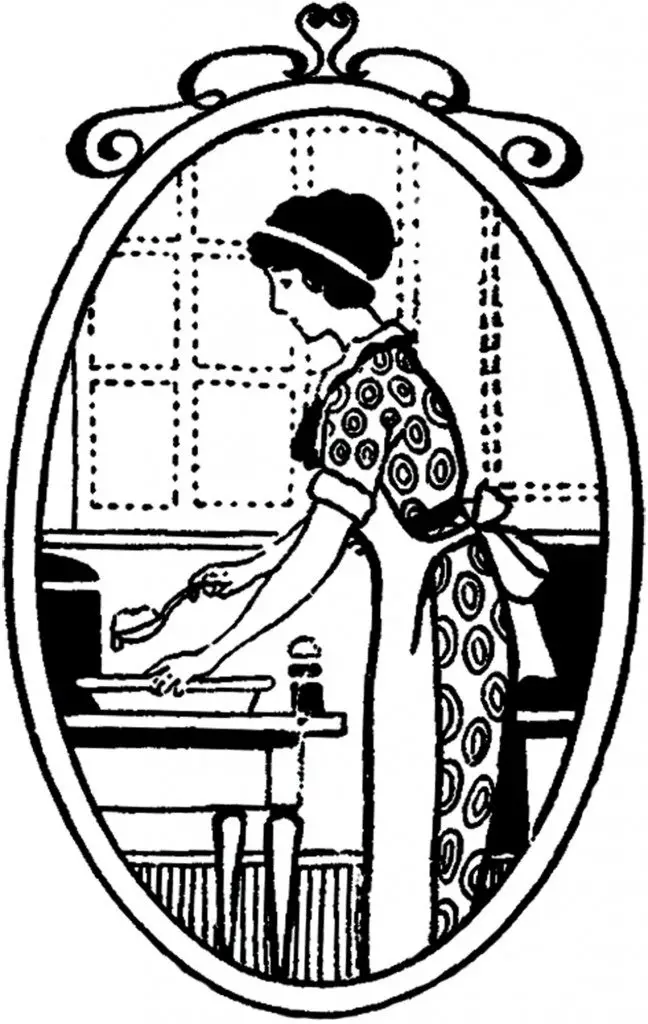To modern eyes, it’s a mockery and a letdown. Imagine unwrapping a brand-new vacuum on Christmas morning instead of, say, jewelry or a luxurious gift set. But to the vintage housewife, a top-of-the-line vacuum cleaner wasn’t just a practical tool—it was a coveted treasure, a sign of progress, and a gift that represented thoughtfulness and care.
It’s time to a closer look at why that vacuum cleaner — or any similar household tool — was a dream gift for midcentury homemakers.

Get Our Mid-Century Mom Daily Routine FREE!
This post contains affiliate links. If you click a link and make a purchase, I may receive, at no additional cost to you, a small commission. Find out more on my Disclosures page, and thank you so much for your support!
Work Less, Live More
In the midcentury home, the tools a housewife relied on were not just purchases—they were investments in her time, energy, and the health of her family. A labor-saving device wasn’t just a convenience; it was a game-changer for her health and sanity.
Have you ever swept a carpet with a broom? Dust goes absolutely everywhere. Sweeping a carpet means dusting everything, covering all the furniture in big pieces of cloth, sweeping — lots of short, hard strokes — then taking off the cloths, carrying them carefully outside before shaking them and folding them, going back inside and dusting the whole room AGAIN, and then putting away the tools you used. HORRENDOUS.
A vacuum promised freedom from this never-ending cycle, cutting literal hours into manageable minutes. With this saved time, homemakers could embrace self-care—lingering over a morning coffee with a friend, reading a favorite book, or simply relaxing. A well-equipped home wasn’t about indulgence; it was about carving out moments of joy amidst daily responsibilities.
A Healthier Home
The practical benefits didn’t stop with convenience—they also extended to health. Cleaner floors, reduced dust, and fresher air meant fewer allergens and illnesses. Refrigerators revolutionized kitchens, keeping meat, dairy, and produce fresh, reducing waste, and ensuring safer meals. With fewer germs and better nutrition, these tools played a pivotal role in creating healthier, happier homes.
By investing in quality tools, housewives of the 1950s elevated their homes and lives. Each appliance was more than just a machine—it was a partner in building a better family life.

This is an Advent binder for the vintage housewife. Each day includes a vintage Christmas poem or story, a housewife activity of the day from the Betty Crocker Busy Days of December countdowns, a 1950s decorating project for the day, and a vintage holiday recipe.
The Myth of Cheap Convenience
Labor-saving devices like vacuums, irons, and refrigerators made a housewife’s tasks more efficient and less physically taxing. Labor-saving devices proliferated once electricity was widely available. On farms, in homes, and at factories, labor-saving devices allowed workers to produce more with less wear and tear on themselves. That kind of efficiency was always been a major part of economic growth — without consumption.
Since the early 2000s, we’ve heard, “Buy, Buy, Buy — it’s your patriotic duty, baby!” The argument is that a consumer-driven economy is the mark of progress. But classical economists would have raised an eyebrow at such arguments. The economy thrives on production, not consumption. Building and creating—whether it’s a sturdy washing machine or a home-cooked meal—adds value. Buying endless replacements for poorly made items only creates waste.
Keeping Up with the Joneses
Families in the 1950s weren’t wealthy enough to buy things just to compete with other influencers of social media! A well-made refrigerator, vacuum, or stove was an investment in the family’s future. These purchases were chosen carefully, often after much saving, because they were meant last for years—or even decades. A brand name meant a reputation for a particular level of craftsmanship or ease of repair.
Keeping up with the Joneses wasn’t about constantly buying—it was about making sure your family had the essentials. Middle-class families didn’t have the luxury of replacing appliances on a whim — and Amazon hauls notwithstanding, they still don’t. Even for the professional families, a new machine represented months or even years of planning.
The Hidden Cost of Cheap
The idea that a family can simply run out and buy another mixer or vacuum whenever they want is a modern fantasy. Actually, for most, replacing a broken appliance isn’t even an option right now. Yet we are surrounded by messages telling us that there’s something wrong if we don’t buy ______.
It’s wasteful. It’s killing the planet. And it’s ruining people’s lives — especially the cheap plastic junk that somehow makes our lives cheaper and coarser and duller.
By rejecting cheap convenience, midcentury housewives ensured their homes ran efficiently, stayed healthy, and reflected thoughtful stewardship. Prosperity wasn’t about how much you could buy—it was about how wisely you could build a life.
Suburban Housewives and Ultimate Prosperity
Suburban housewives were seen as the epitome of midcentury success. Their lives contrasted sharply with earlier generations, where families crowded into single rooms or makeshift shacks during the housing shortages after WWII. The post-war housing boom brought clean, modern homes with gleaming kitchens, tidy front lawns, and, for many, space for the latest conveniences.
For these women, a vacuum wasn’t a frivolity—it was a practical investment that made life manageable. Owning one allowed them to maintain their new, larger, homes with ease. They could maintain a much larger area of sparkling-clean floors and dust-free furniture, but still have time for caring for children, cooking healthy meals, and often even working.
The family car added another layer of independence. With a reliable vehicle, suburban housewives could leave their neighborhoods and explore the world. Trips to the city for shopping, errands at a suburban mall, or marketing at the grocer’s became part of their weekly routines.
These excursions weren’t just chores; they were opportunities to experience life beyond the home, dress up in their best outfits, and connect with other women in their communities. And women needed the extra time away from housekeeping that labor-saving device provided to experience this kind of social freedom.
Take, for instance, Mary, a mother of three living in a new housing development outside Chicago. Her husband surprised her with a Hoover vacuum for their anniversary—a gift she later called the best she’d ever received. Mary recounted how it cut her cleaning time in half, giving her afternoons to teach piano lessons and sew her daughters’ dresses.
Or consider Abigail, whose family saved for a year to buy their first car. For her, it wasn’t just a vehicle—it was a lifeline. Abigail used it to drive her children to school, pick out her own groceries and produce, and even attend evening classes at the local college while her husband worked — and all she had to do to use it was drop him at the train station in the morning.
These stories remind us that what might seem mundane today was transformative in the midcentury. A vacuum cleaner wasn’t just a tool; it was a luxury that symbolized independence, efficiency, and the promise of a brighter future for housewives and their families.

The Work of Husbands
The expectations placed on midcentury husbands were no less demanding than those faced by housewives. Men were expected to work long hours in often soul-draining jobs, enduring the stress and monotony of corporate or industrial life to ensure their families lived in appropriate comfort.
While modern social media rails against modern corporate work demands, it rarely considers what that meant for the vintage husbands that they mock and denigrate for “laziness.” These men shouldered these burdens and squashed down their feelings and complaints — because it was their duty.
The Reality of Vintage Responsibilities
Yes, housework is often harder than office work—physically demanding, emotionally taxing, and relentless. But that doesn’t mean men were slacking off.
A husband’s responsibilities didn’t end when he hung up his work hat. The evenings and weekends were filled with repairs, maintenance, and yard work, often squeezing these tasks into the few hours of personal time they might have had. Fixing a leaky faucet, mowing the lawn, or painting the house weren’t optional—they were part of keeping the home running smoothly, and maintaining the family’s standing in the community. They were an expectation.
And let’s not forget the pressure to provide. There was no “quiet quitting” in the 1950s. A husband couldn’t simply decide he wanted to leave the corporate rat race without risking his family’s well-being. His role was to ensure stability, even if the cost was his own personal fulfillment.
A successful home requires both husband and wife to contribute fully. The wife who manages the household with efficiency and grace, maximizes the efforts of the husband who works to provide the resources and physical upkeep.
This was equally true in midcentury America. Neither one would shirk their duties, if they cared that their family’s comfort and happiness depended on it.
That DOESN’T mean that there were not plenty of selfish people — men and women — living only for themselves. After all, there are plenty of those today. The difference was the amount of social disapproval for a woman saying she didn’t need to care for her kids, or a man whining that he couldn’t find a job.
It wasn’t about who worked harder—it was about both adults stepping up to meet their responsibilities before indulging in leisure. A man might dream of a day spent fishing, but not until the gutters were cleared and the lawn mowed. Likewise, a woman might long to curl up with a book, but not before the dishes were done and the children tucked into bed.

The True Luxury of Labor-Saving Tools
Housework was physically demanding before the rise of modern appliances. And it took time. And energy. It broke you down. Have you ever done a wash without a washing machine? In the Victorian era, it was thought that this work was SO back-creaking, on strong immigrant women of sturdy peasant stock could survive doing it — hence the “Irish Washerwoman” trope.
For the housewife, these tools were literally lifesavers. Less physical strain meant more energy, better health, and well-being, instead of the exhaustion so deep, you can’t even sleep when you fall into bed at night.
There was time for personal development (and the energy for it) and for self-care routines. There was time to make a proper supper, instead of a hasty meal. After all, a woman who spends all day beating rugs into submission doesn’t have much energy left to enjoy her evenings or take care of herself.
The Value of Leisure
Midcentury society placed a high value on leisure time, seeing it as time for hobbies, recreation, social development, and self-improvement. These weren’t looked at as indulgences, either. Leisure was seen as essential to society and civilization.
A homemaker who had time to sew, paint, read, or volunteer was contributing to her community and cultivating a sense of purpose beyond daily chores. In fact, in midcentury America and before, the entire social safety net was provided by stay-at-home wives and mothers devoting their leisure time and energy to helping others. Charity WAS personal.
A Housewife’s Personal Goals
Home economics experts of the era also stressed that time-saving tools were crucial for creating the “feeling of home.” If a housewife was overwhelmed by her chores, she couldn’t be emotionally present for her children or provide the warmth and stability that turned a house into a haven. Excessive time spent on drudgery eroded the joyful, nurturing atmosphere families relied on.
With time freed by efficient tools, midcentury housewives could focus on personal aspirations. They could even go out and work — 20 million American housewives were doing just that in 1950.
The ultimate goal was balance. A home wasn’t just clean; it was vibrant and alive. Labor-saving devices gave women the ability to uphold high housekeeping standards while also nurturing the emotional and intellectual needs of their families—and themselves.
A Love Language from the Great Depression
The gift of a tool was a way for a husband to say, I see you, I value what you do, and I want to make it easier for you. These gifts lightened her daily load, giving her more time to breathe, more time to rest, and more time to focus on what brought her joy.
Contrast this with modern social media, which claims that a vintage housewife “should have wanted” a diamond necklace for all the work she did.
First of all — good jewelry is also an investment, so no shade there. But buying cheap trinkets? Contrast this with a vacuum.
Sure a cheap lead-and-zamak necklace from a chain store can be cute. But it doesn’t change the course of your day. A sparkling brooch won’t reduce the time spent folding laundry or cleaning up after dinner.
But for a vintage housewife, a vacuum cleaner or washing machine could transform her routines. That was much more important to most of them — providing them with far more rest than a cheap piece of glitter (Again, not talking about real jewelry! If your husband is buying real jewelry you have MADE IT.)
Shared Prosperity
These investments, then and now, were part of the shared prosperity of a household. A labor-saving device didn’t just benefit the wife; it improved life for everyone under the roof. Clean, dust-free homes meant healthier children. Efficient laundry routines meant crisp, fresh clothes for the whole family. Time saved on household chores became family time, learning time, productive time.
For a husband, giving such a gift also symbolized his commitment to making life better for his family. His hard work provided the means to afford these innovations, and his choice to invest in tools rather than trinkets spoke volumes about his priorities.
When housewives smiled at a new appliance under the Christmas tree, they weren’t settling for less. They were celebrating a shared vision of progress, partnership, and purpose.
Today, the idea of giving (or receiving) practical gifts might seem unromantic, but it’s worth reevaluating that perspective. A tool that improves your daily life, reduces your workload, and offers lasting value is a gift of thoughtfulness, not of neglect.
In many ways, the vintage housewife had the right idea: prioritizing quality, sustainability, and shared labor over fleeting trends or disposable convenience.
So, the next time someone gives you a practical gift, consider the bigger picture—it just might be the most thoughtful gift of all.

Get Our Mid-Century Mom Daily Routine FREE!




